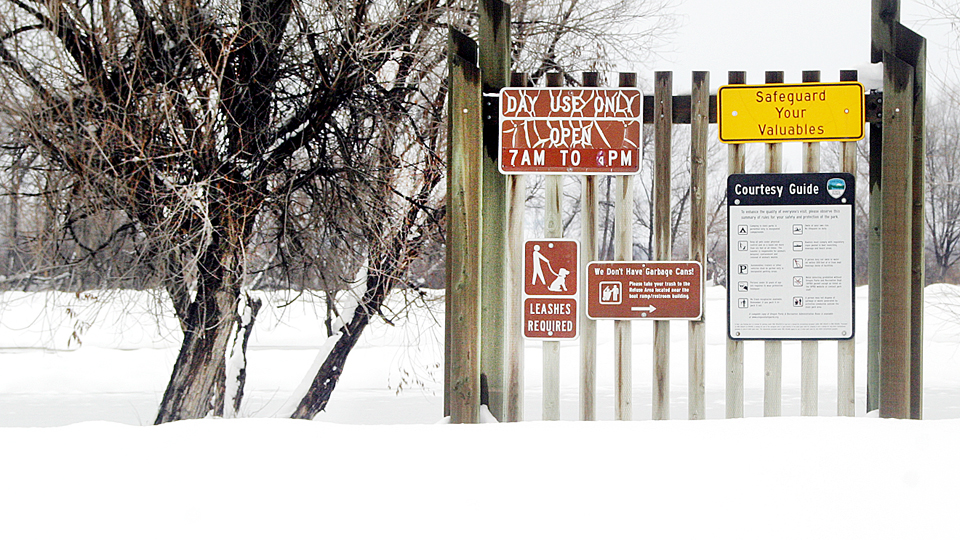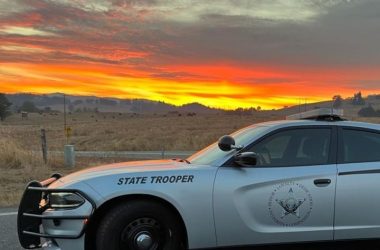
 Snow piles up at the day use area by the ice-jammed river in Ontario.
Snow piles up at the day use area by the ice-jammed river in Ontario.By Pat Caldwell
and John L. Braese
The Enterprise
Snow-slicked roads, blizzard conditions and numbing cold challenge local emergency responders, but agency officials say their crews are pressing on to reach residents in need.
With the recent record snowfall, law enforcement and fire and ambulance services have been operating in high gear. In some cases, response time may be delayed by conditions, but the services are still reaching those who phone 911, officials say.
Terry Leighton, Ontario fire chief, said the weather has been “very challenging” for fire crews. He said his department switched to a chained-up, four-wheel-drive brush rig as its first response on emergency calls.
Still, Leighton said, “We got stuck numerous times. The ambulance got stuck numerous times.”
He said the snow didn’t affect overall response times but “made it a lot tougher. It was much tougher to roll a gurney.”
Emergency calls lately have included people injured in falls and others with breathing and chest issues because of exertion.
He said Monday that he knew of no injuries from collapsing buildings.
“We have been very, very lucky,” Leighton said.
Surprisingly, the visits to the local hospital have been fewer than expected according to one doctore.
Dr. Mitch Long of Saint Alphonsus Medical Center said the hospital’s emergency room has treated a “few more fall injuries” but “not the number I would have expected.”
He said transporting patients has been the biggest challenge.
“Transport times are quite a bit longer and a bit more dangerous,” he said. He said last week as another storm hit, the Ontario hospital couldn’t get patients transferred to Boise because of bad road conditions.
He said some people have waited too long to get medical care, worried about the road conditions.
“Rather than go to the doctor, they try to tough it out, they get worse, and we seem them in the emergency room,” Long said.
He said getting patients home who arrived by ambulance hasn’t been easy on occasion. Some don’t have cars that do well on snow-covered roads, he said. The reverse has been true as well – patients not comfortable with driving have called ambulances.
In addition to their regular duties, Malheur County Sheriff’s deputies have been helping people get cars out, shovel walkways and check on their roof safety.
“Been dealing with a lot of people. By that I mean anything from helping them get unstuck, to calling them about their roofs. Some people are snowed in at their residences and they don’t have the resources to hire someone to come dig them out,” Sheriff Brian Wolfe said.
The snow storms also translated into extra hours for his staff, he said. That can be a juggling act, he said.
“So when we get these storms, we have been calling in extra people. But, at the same time, we can’t call everyone in because we have the next operational period and need people ready for that,” Wolfe said.
Wolfe’s counterparts in Ontario and Nyssa also face new challenges. Ontario Police Chief Cal Kunz said fierce snow storms create an array of challenges.
“Any time a major event happens like this it is tasking for all the city entities, including the police department,” he said.
Building roof collapses and traffic accidents caused by snow create plenty of work for police Kunz said.
“We are doing the best we can to stay on top of it. Our biggest concern is pedestrians walking in the roadway. Obviously there are a lot of sidewalks they can’t pass,” he said.
In Nyssa, police chief Ray Rau said his officers spent a lot of time pulling stuck vehicles out of the snow and helping seniors and disabled residents trapped by the storms.
Rau also said the Nyssa Public Works crew worked nearly non-stop in January.’
“This (last) weekend was the first one the whole crew did not work through the weekend. They’ve done that for three weeks,” he said.
Crews from Vale Ambulance are running to calls without lights and sirens, to avoid creating unfortunate ripple effects.
“People attempting to get out of the way become more of a problem with the current road conditions,” said supervisor Todd Hesse.
Hesse said the vehicles do have chains on and remain indoors during this time of the year.
However, getting to the scene is only half the battle.
“Right now, we are having problems getting the gurney from the ambulance to the house because of the deep snow,” said Hesse. “Many times, we are using a stair chair to transport the person from the home to the ambulance. We have also implemented having a third person respond to the calls to assist in transporting the person to the ambulance.”
And calls are on the rise.
“We are having quite a few cardiac calls due to people getting out and shoveling snow,” Hesse said.
Hesse said the rise also involves falls from icy conditions and motor vehicle crashes.
“People need to remember that although it is cold outside, they still need to remain well hydrated,” he said. “People forget that although it is cold, physical exertion still calls for the body to be hydrated. We are receiving calls that involve people just needing to be hydrated due to being outside and moving snow.”
Neither Vale Ambulance nor Treasure Valley Paramedics currently have vehicles equipped with four-wheel drive.
“Up until this year, we have always been able to get around without too many problems,” said Hesse. “The cost and trying to find an ambulance equipped with four-wheel drive has always made it prohibitive.”




